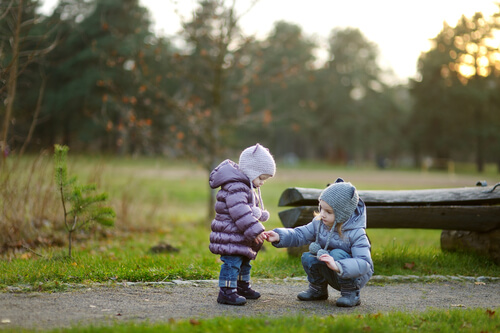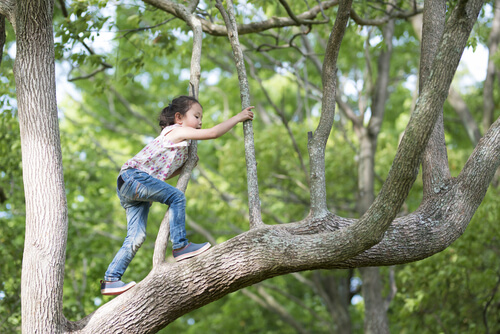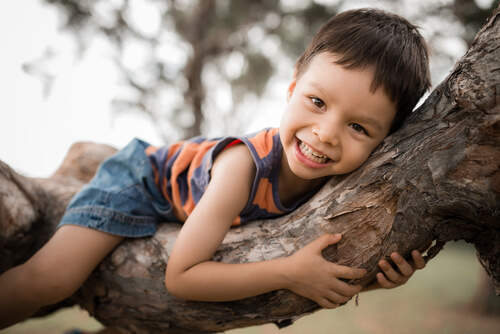
Table of contents
At outdoor nurseries, children spend their time playing and learning in the great outdoors all day, every day.
Climbing, playing with sticks, building dens and exploring the flora and fauna of the forest are just some of the activities an outdoor nursery offers to a child – all they need is waterproof clothing.
After the first UK outdoor nursery opened its ‘doors’ in Scotland in 2008, the developmental benefits and the endless learning opportunities of outdoor nurseries are becoming increasingly recognised. By playing outside, children have the opportunity to connect with the natural world and experience their surroundings on their own.
Here you can learn more about how outdoor nurseries work, how outdoor learning benefits growth in children and how the early years curriculum is applied in the natural environment.
How do outdoor nurseries work?
An outdoor nursery will have an indoor site for drop-offs and pick-ups but will normally only be used as such, except during strong winds or extreme weather. The children spend the rest of their time outside to explore and discover the natural environment, using outdoor play as learning experiences.
The method is similar to forest school, but as opposed to being a session-based programme as part of a nursery or preschool, outdoor nurseries take outdoor learning one step further and take children outside every day.
After a meeting in the morning at the base camp close to the indoor site to plan the day, the group of children, supervised and led by staff, head into the woods or gardens for child-led activities.
All play and learning take place outside, planned according to the early years frameworks in England, Wales, Scotland and Northern Ireland.
Outdoor nursery activities include:
- Tree climbing
- Building dens
- Rope swings
- Adventure walks
- Hide and seek
- Minibeast hunts
- Bug hunting
- Arts and crafts using sticks and leaves
- Painting
- Identifying and recording plants
- Cooking in mud kitchens
- Storytelling
Day-to-day, activities are varied, and children are encouraged to use their imagination, creativity and curiosity to lead the way in their own learning. Staff supervise and support the children where necessary to ensure they reach their goals.
Meals are either had back at the base camp/indoor setting or enjoyed as a picnic outside. Throughout the day, staff make notes on how children approach resources, interact with each other and what the outcomes are.
Ensuring safety of children
Keeping children safe is paramount and while certain activities do pose some risks, staff are always on hand to monitor the children and to ensure nothing goes wrong.

Otis Lindblom-Smith, nursery manager at Little Forest Folk, Chiswick, stressed that a risk assessment of the site is undertaken each day by one of the managers, including testing the ropes and making sure boundaries are clear and in place.
Mr Lindblom-Smith said that while the use of tools is often seen as the riskiest part of the setting, “They are actually one of our safest activities.”
“This is because a forest school trained staff member is always leading the activity and in control of the tool. An example of this would be when teaching a child to use a bow saw, the educator and staff are wearing safety gloves and the child is first taught how to kneel and where to place their hands.”
Taking risks helps children build their self-belief and grow confidence as they overcome challenges.
How does outdoor play benefit children?
An outdoor approach to early learning and childcare brings a wide variety of benefits to children’s health and development. In addition to exploring and creating an understanding of the world around them, the physical activity helps children to keep fit and healthy.
With endless learning activities available, children are constantly allowed to try new things, solve problems, work and engage with their peers and build confidence by overcoming challenges on their own, with the support from practitioners.
Health benefits of outdoor play include:
- Developing physical fitness, preventing obesity
- Jumping and running helps bone density
- Improving balance, coordination and strength
- Better eye health – Spending time outdoors reduces short-sightedness in children
Outdoor play is an important part in children’s development and healthy growth. The NHS recommends that toddlers and pre-school aged children should engage in at least three hours of physical activity per day.
Outdoor learning gives children a sense of freedom which can be difficult to create inside a classroom and turns education into something enjoyable rather than a chore.
Mr Lindblom-Smith has worked in schools as well as indoor nurseries and has noticed a big difference in children’s development.
“Having worked in schools and indoor nurseries before, I have noticed that children at forest nurseries have developed at a faster rate into individual, confident and inspirational little people.
“This I believe is down to their enjoyment of learning, their socialising with mixed age ranges and the trust and confidence forest educators instil in children through allowing them to take risks and make decisions through child-led play.”
Outdoor nurseries and the early years curriculum
There is a vast amount of opportunities to cover all areas of the early years frameworks at outdoor nurseries through the number of learning experiences and resources children have access to.

For example, in England, the Early Years Foundation Stage (EYFS) curriculum’s seven areas of learning covers:
- Communication and language
- Physical development
- Personal, social and emotional development
- Literacy
- Maths
- Understanding the world
- Expressive arts and design
Being outside every day is the perfect opportunity for children to understand the world around them, exploring the smells and sounds of nature and basic science.
Activities at outdoor nurseries are often done in groups, encouraging children to engage in roleplay, listen to each other and tell stories to improve their communication and language.
Physical development comes naturally, as children are always on the move up and down trees, digging holes, going for walks or building dens. This helps children test their limits and strength.
Through the various group activities, children learn to negotiate with each other and work together, building on their social skills and emotional development.
The great outdoors offers endless opportunities for expressive arts as the natural, open-ended resources available to children can all be used to stimulate their imagination. This includes making leaf pictures or weaving grass.
To improve their maths skills, children can count sticks or play around with the many shapes found in the wild. To develop their literacy, children can make letters and words using natural objects instead of writing them on a piece of paper.


